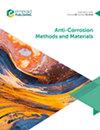温度对Zn-Ni合金在深共晶溶剂中电子出核及生长机理的影响
IF 2.6
4区 材料科学
Q2 METALLURGY & METALLURGICAL ENGINEERING
引用次数: 0
摘要
目的研究ChCl–Urea中温度对Zn–Ni合金的影响。设计/方法/方法基于循环伏安法实验,研究了Zn–镍合金的沉积行为和动力学。通过计时电流法实验详细研究了锌镍合金的形核过程。通过扫描电子显微镜和X射线衍射(XRD)结合经典热力学,研究了沉积温度对Zn–Ni合金涂层微观结构、Ni含量和相组成的影响。结果表明,随着温度的升高,还原峰向更正的电势移动,这有利于共电沉积过程,并估计了扩散系数。随着温度的升高,Zn–Ni合金的形核过程变成三维瞬时形核,使用标准的三维生长扩散控制模型确定了典型的动力学参数,并估计了吉布斯自由能。Zn–Ni合金涂层是通过常规共沉积制备的。随着温度的升高,结晶度增加,涂层逐渐均匀致密,XRD峰强度增加。原创性/价值分析了Zn–Ni合金在不同温度下的形核过程。计算了扩散系数D和吉布斯自由能。分析了三种过程在不同温度下的作用。研究了温度对锌镍合金镀层形貌的影响。本文章由计算机程序翻译,如有差异,请以英文原文为准。
Effect of temperature on electronucleation and growth mechanism of Zn–Ni alloy in deep eutectic solvent
Purpose
The purpose of this paper is to study the effect of temperature on Zn–Ni alloys in ChCl–Urea.
Design/methodology/approach
Based on cyclic voltammetry experiments, the deposition behavior and kinetics of the Zn–Ni alloy are studied. The nucleation process of the Zn–Ni alloy is studied in detail via chronoamperometry experiments. The effects of the deposition temperature on the microstructure, Ni content and phase composition of Zn–Ni alloy coatings are investigated via scanning electron microscopy and X-ray diffraction (XRD) combined with classical thermodynamics.
Findings
The results show that with increasing temperature, the reduction peak shifts toward a more positive electric potential, which is beneficial for the co-electric deposition process, and the diffusion coefficient is estimated. With increasing temperature, the nucleation process of the Zn–Ni alloy becomes a three-dimensional instantaneous nucleation, the typical kinetic parameters are determined using the standard 3D growth proliferation control model and the Gibbs free energy is estimated. The Zn–Ni alloy coatings are prepared via normal co-deposition. With increasing temperature, the degree of crystallinity increases, the coating gradually becomes uniform and compact and the XRD peak intensity increases.
Originality/value
The nucleation process of the Zn–Ni alloy at different temperatures is analyzed. The diffusion coefficient D and Gibbs free energy are calculated. The contribution of the three processes at different temperatures is analyzed. The effect of temperature on the morphology of the Zn–Ni alloy coatings is studied.
求助全文
通过发布文献求助,成功后即可免费获取论文全文。
去求助
来源期刊

Anti-corrosion Methods and Materials
工程技术-冶金工程
CiteScore
2.80
自引率
16.70%
发文量
61
审稿时长
13.5 months
期刊介绍:
Anti-Corrosion Methods and Materials publishes a broad coverage of the materials and techniques employed in corrosion prevention. Coverage is essentially of a practical nature and designed to be of material benefit to those working in the field. Proven applications are covered together with company news and new product information. Anti-Corrosion Methods and Materials now also includes research articles that reflect the most interesting and strategically important research and development activities from around the world.
Every year, industry pays a massive and rising cost for its corrosion problems. Research and development into new materials, processes and initiatives to combat this loss is increasing, and new findings are constantly coming to light which can help to beat corrosion problems throughout industry. This journal uniquely focuses on these exciting developments to make essential reading for anyone aiming to regain profits lost through corrosion difficulties.
• New methods, materials and software
• New developments in research and industry
• Stainless steels
• Protection of structural steelwork
• Industry update, conference news, dates and events
• Environmental issues
• Health & safety, including EC regulations
• Corrosion monitoring and plant health assessment
• The latest equipment and processes
• Corrosion cost and corrosion risk management.
 求助内容:
求助内容: 应助结果提醒方式:
应助结果提醒方式:


